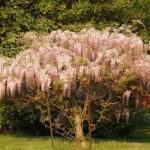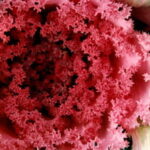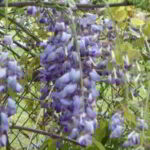Vines climb, trail, creep or even remain erect without support. Some vines are grown for profuse and fragrant bloom, others, for colorful foliage or berries. Some are useful for their dense or persistent foliage. The most useful vines, in the landscape are perennial plants but there are a few annual species that may be started from seeds each year and still provide dramatic summer effects.
Vines are seldom considered as a means for quick shade. However, if supports are provided, such as in arbors, pergolas, or similar framing, vigorous perennial vines can cover patio and outdoor areas quickly. Wisteria, porcelain berry, bittersweet, trumpet vine, and Virginia creeper are a few vigorous vines that might serve this purpose. The extreme vigor of some of these vines may require pruning to keep them from invading areas where they may not be wanted.
Fences, screens, or walls are sometimes long and uninteresting. Vines can be used to break up their length and soften the lines. Chain link, or similar open wire fences, may not provide privacy desired, but can be easily covered with vines. Both annual or perennial vines might be used for such purposes. Morning glories, Scarlet runner bean, or moonvine are a few annual vines that may be started from seeds and provide quick summer screening on these types of structures. Perennials that attach to such fences include clematis or perennial sweet pea.
Many urban lots are fairly small, needing privacy around the patio area. A relatively inexpensive structure can be built and covered with vines in much less space than would be required for a screening of shrubs. A vine covered screen will also seem softer and more natural than a screen made entirely from wood. It will also allow more air movement than most wooden privacy structures. Vines are also useful for indoor temperature control, particularly for walls that are exposed to full afternoon sun that tend to become excessively hot in summer.
Some vines may attach directly to brick or stone, however many people prefer to use wires or structures on which the vines may twine. In addition to their use on vertical structures, vines are also useful on horizontal surfaces and may become groundcovers in shady areas, or on banks where other plants can not be grown. English ivy is an evergreen vine that is often used as a ground cover for shady places. Baltic ivy is a selection of English ivy that is among the hardiest of this group. For steep banks vines such as Hall’s Japanese honeysuckle may sometimes be useful.
This very vigorous vine should not be planted among trees on which it may also climb. Vines climb in one of three ways: tendrils (sweetpea, clematis), adhesive disks or aerial roots (Virginia creeper, English ivy), or twining stems (morning glory, bittersweet). Properly selected, vines generally require little maintenance after they are established. They may need occasional pruning to train them into the required shape, or to keep them within the desired boundaries.
http://gardeningfromthegroundup.us/ornamental_vines.html
http://ppp.missouri.edu/newsletters/meg/archives/v6n1/meg6.htm






